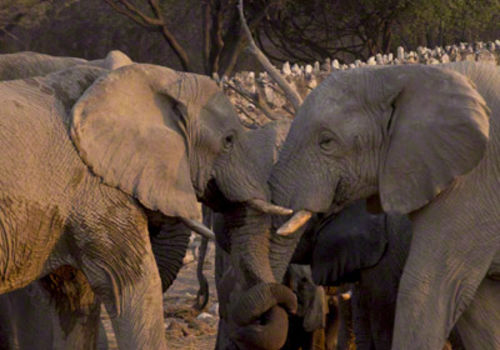
Elephant
Loxodonta africanaElephant
Introduction: The elephant (Loxodonta africana) is the world's largest land mammal. All the elephants found in Namibia are African elephants which live in small families of between 10 and 20 animals. These groups frequently congregate in larger herds at communal waterholes, led by dominant females (matriarchs). Bulls live alone or in small bachelor groups, only joining the herds when the cows are in season. Males can be identified with a rounded rather than angular foreheads and thicker tusks. The flaps of the ears are very large, reaching a height of 2m and a breadth of 1.2m.
Elephants can live up to 70. The massive tusks of older bulls can weigh up to 50 or 60kg, but tusks weighing up to 90kg have been recorded. An elephant's hearing and smell are excellent. Eyesight is moderate and best in dim light. The hair from the tail is a much sought after commodity for pipe cleaners and bracelets. The trunk, which is such a feature on the elephant, has many uses:
It can be used in conjunction with the tusks to break down branches; it can pluck bundles of grass by curling up the end of the trunk around the stems; it can convey food to the mouth. They drink by filling the trunk with water and squirting it in to their mouths; they cool themselves by spraying it over their bodies. During droughts, they will dig for water, using first the tusks, then the trunk.
Distribution: In Namibia, elephants can be found in great numbers in the Etosha National Park, especially during the drier winter months. In the north-east of the country and the Zambezi Region (formerly the Caprivi Strip) they roam freely between the Okavango Delta in Botswana, Zimbabwe, Zambia and Angola. Namibia also has a population of desert-adapted elephants, which can be found throughout Damaraland and the Kaokoveld.
Diet: An adult elephant eats around 250kg of vegetation every day (leaves, bark and grass) for over fourteen hours a day. These feeding patterns modify woodlands in the process. They are dependent on water and can drink up to 200 litres in a single session
Colouring: Grey, often obscured by their habit of dusting and mud-wallowing, assuming the colour of the soil in which they carry out this practice.
Breeding: African elephants are not seasonal breeders. Generally they produce one calf every 3 to 4 years. The gestation period is about 22 months. At birth, calves weigh about 100kg and are fully weaned between 18-24 months.
Size: The largest males can weigh up to 6,000kg and stand 4.0m at the shoulder
Klein Windhoek

